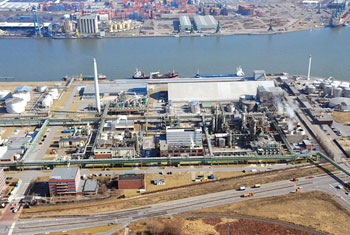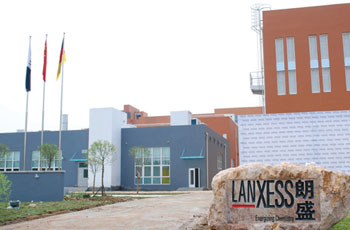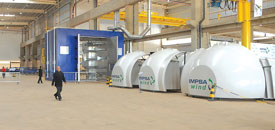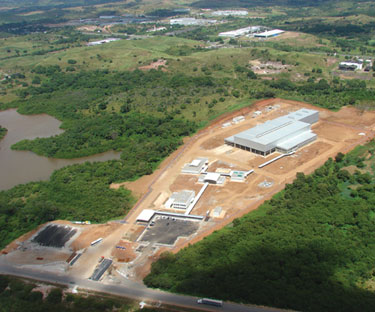
Expanding Globally


erman specialty chemicals group Lanxess AG is in the midst of several major expansion projects around the globe. Lanxess, now with 44 production sites worldwide, focuses on development, manufacture and sale of plastics, rubber, intermediates and specialty chemicals.
The company is investing US$47.5 million to expand capacity of its caprolactam plant in the port of Antwerp by 10 percent. About half of the products produced at the Antwerp facility go into the production of heavy-duty plastic components for the automotive industry. In addition to caprolactam, Lanxess also produces glass fibers in the port of Antwerp, where it operates a world-scale plant. These glass fibers are another of the raw materials used in the manufacture of high-performance plastics.
“This investment will consolidate our excellent position in the global plastics business,” said Rainier van Roessel, a member of the Lanxess board of management. “It is another step on the way to profitable growth. At the same time, it is a clear declaration of faith in our Antwerp site. In conjunction with the ongoing measures to improve efficiency, the investment will further improve the competitiveness of this site.”
Lanxess launched operation of a pelletizing plant for EPDM rubber in late September at its Marl, Germany, location. For the first time, the company can now additionally manufacture this rubber grade in the form of pellets, two to three millimeters in size, in its own facility and market them on a commercial scale.
Lanxess also has opened a new center for rubber research in Qingdao, China, near the center of China’s rubber industry. The Technical Rubber Products, Butyl Rubber and Performance Butadiene Rubbers business units have invested about $13.5 million in the joint project. The new research center is located near the Qingdao University of Science & Technology, enabling close cooperation.
“The new Lanxess research center covers the entire research spectrum from basic research and technical customer service to preparation for the commercial exploitation of new developments,” said Günther Weymans, head of the Technical Rubber Products segment.
Lanxess said the Asia-Pacific region now accounts for about 40 percent of the global rubber market. The company also anticipates high growth rates for this region in the future, attributable mainly to the Chinese rubber market.
P and China’s Chongqing Municipality plan an advanced manufacturing complex to produce notebook and desktop PCs for the Chinese market. HP, the leading foreign manufacturer of PCs in China, plans to operate a 20,000-sq.-m. (215,400-sq.-ft.) facility in Chongqing by 2010.
“Our vision of transforming Chongqing into China’s West IT center requires strong participation from the world’s most innovative and respected companies,” said Wang Hongju, mayor, Chongqing Municipality. Chongqing is one of the fastest growing cities in China, with 500,000 university students and more than 1,000 R&D institutions. HP also has manufacturing operations in Shanghai.

alo Alto, Calif.-based online social networking firm Facebook has tapped Dublin for the site of its international headquarters. Facebook, which is evaluating potential sites in the city, said the facility will provide online technical, sales and operations support to users and customers across Europe, the Middle East and Africa.
Facebook Chief Operating Officer Sheryl Sandberg explained, “After exploring various locations throughout the region, we decided Ireland was the best place to establish our new headquarters. The talent pool in Dublin is world-class, and recruiting local talent will help us better understand the needs of local users and the regional dynamics that, in turn, can give us better insight into what features matter most.”
The Irish Computer Society reports that Facebook has more than doubled in size in Ireland in less than a year, moving from 131,660 users in October 2007 to 308,200 in October 2008.
“The massive growth rate of Facebook is an indication of the evolving way people are interacting with each other, and it shows that social networks are the new playgrounds, break rooms and community centers for the current generation,” said Jim Friars, CEO of the Irish Computer Society. “With a million people on broadband in Ireland, massive percentages are hanging around in Facebook and other social networks.”
Facebook joins a growing list of technology companies – including Apple, Adobe, Microsoft and Google – who are enjoying Ireland’s relatively low corporate tax rate of 12.5 percent.
rgentina-based IMPSA Wind opened a factory in Puerto de Suape, Pernambuco, Brazil, the first in the country devoted to the production of wind power turbines and generators. The factory is located at the Suape port complex. This new production center is on a 67-acre (27-hectare) property.


IMPSA says the factory will produce 66 wind power generating units of 1.5 MW during its first year, which will be installed in three wind-powered parks at Ceará. The projects are Praia do Morgado (28.8 MW), Praias de Parajuru (28.8 MW) and Volta do Rio (42 MW). The next 145 generators to be manufactured will be installed in 10 wind-powered parks located in Santa Catarina during 2009.
The plant will have capacity to manufacture 200 wind-powered 1.5-MW generators per year. Depending on the demand, the annual capacity will be able to be increased to 300 units (450 MW). Beginning in 2010, the factory will also manufacture turbines and generators for large hydroelectrical power stations. Future expansion plans include the creation of a blade factory.
“Brazil provides excellent opportunities for the development of renewable energies, such as hydroelectrical and wind-powered energy,” said Luis Pescarmona, general director of the IMPSA Wind group in Brazil. “The quality of winds here is two times better than the world average, and I am sure that if a firm sustainable policy is implemented in this country, the national market will show a growing demand. At the same time, this will turn this industry more competitive for the energetic sector.”
The factory will employ 300 by the end of 2008. IMPSA said it chose Puerto de Suape for the facility because it is one of the most important multimodal ports in the region and offers infrastructure critical for import and export activities. The company said tax incentives enacted by the government of Pernambuco were an important factor, as was the fact that 70 percent of Brazil’s wind power potential is in the country’s northeast.
Site Selection Online – The magazine of Corporate Real Estate Strategy and Area Economic Development.
©2008 Conway Data, Inc. All rights reserved. SiteNet data is from many sources and not warranted to be accurate or current.